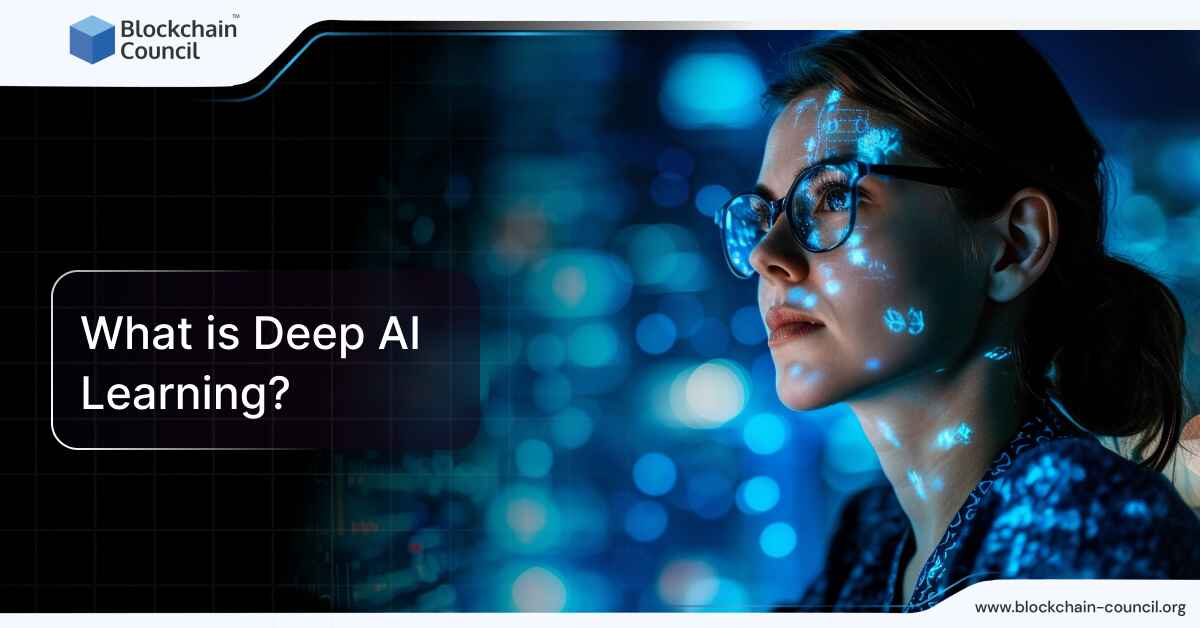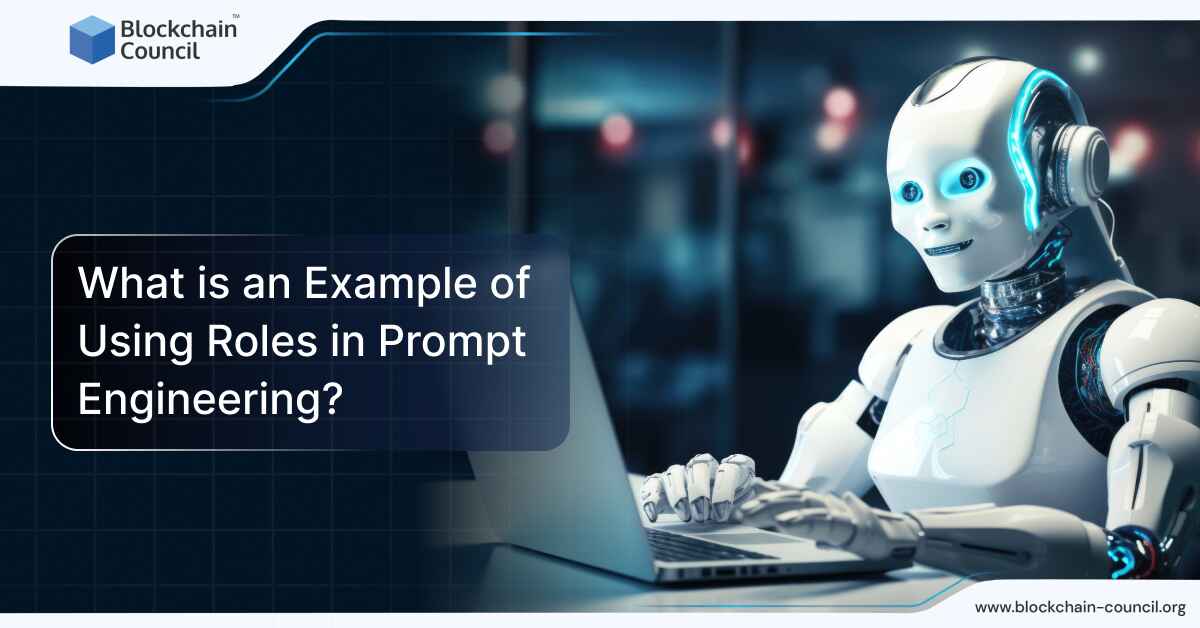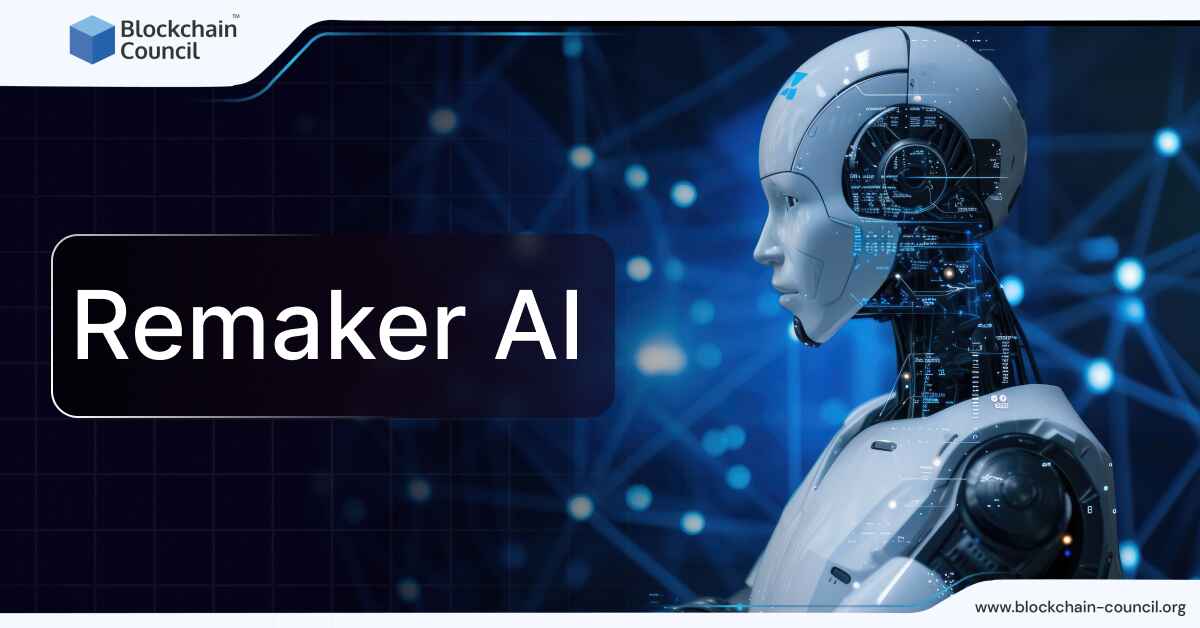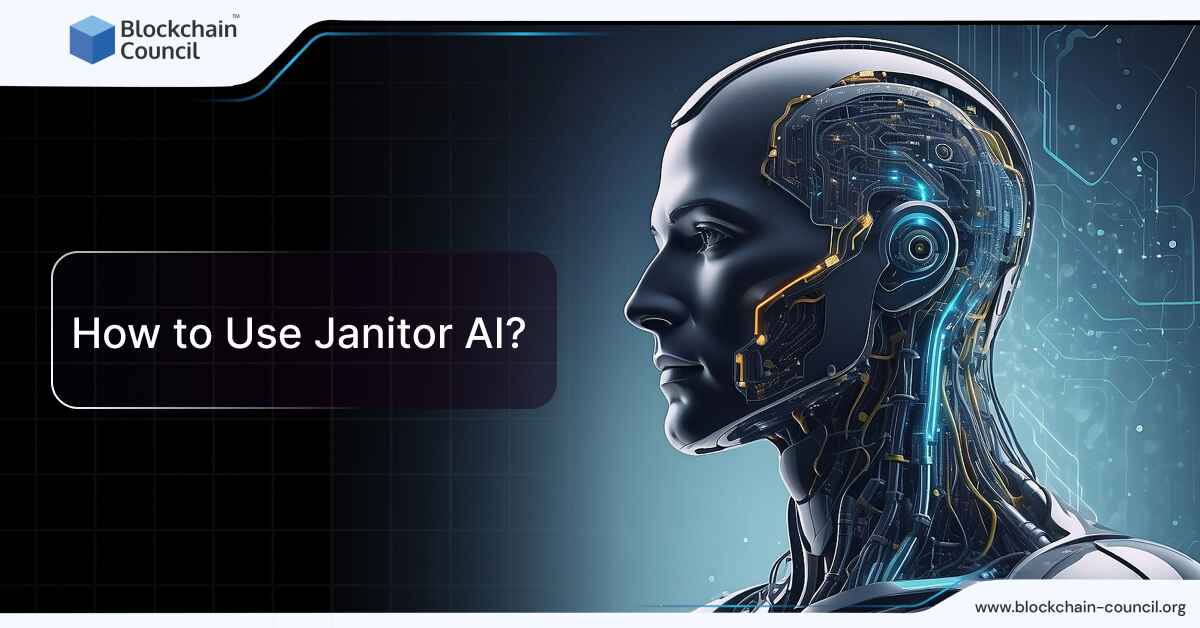
- Blockchain Council
- September 02, 2024
Summary
- Deep learning, a subset of AI and ML, utilizes deep neural networks to process data.
- It is vital for various technologies like voice recognition and recommendation engines.
- It stands out for its hierarchical structure, learning complex patterns through multiple layers of nodes.
- Key concepts include artificial neurons, activation functions, and different learning types like supervised and unsupervised learning.
- Deep learning involves forward and backward propagation, adjusting weights and biases to minimize errors in predictions.
- Applications span industries like self-driving cars, healthcare diagnostics, and fraud detection in banking.
- Challenges include data requirements, computational resources, transparency, and ethical considerations regarding bias and privacy.
- Trends like generative AI, AI hardware innovation, and customized local models are shaping its evolution.
- Despite challenges, deep learning promises transformative impacts, improving technology and society as a whole.
In recent years, the field of artificial intelligence (AI) has made significant strides, with deep learning standing out as a crucial driver of innovation. It is the backbone of many technologies we use daily, from voice recognition systems like those in our smartphones to recommendation engines suggesting what to watch next on streaming platforms.
As we generate more data every day, the role of deep learning in making sense of this information grows increasingly vital. In this article, we will understand what exactly Deep AI learning is, how it works, what makes it so special, and how it differs from other branches of AI. By the end of this article, you will have a clear picture of the role of Deep Learning in today’s world.
What is Deep AI Learning? Definition
Deep AI learning, often just called deep learning, is a sophisticated method within the broader field of machine learning. It is itself a part of artificial intelligence (AI). It stands out because it uses what are known as deep neural networks—structures inspired by the human brain’s own network of neurons.
These networks consist of layers upon layers of nodes that process data, allowing the machine to learn complex patterns and make decisions.
The “deep” in deep learning refers to the presence of multiple layers that help the system learn from data in a structured, hierarchical fashion. It’s like building a tall tower where each block is a piece of knowledge, and the more blocks you have, the more detailed and nuanced that knowledge becomes.
Also Read: What are the Applications of Reinforcement Learning (RL)?
Basic Concepts of Deep Learning
- Neurons and Neural Networks: At the heart of deep learning are artificial neurons, which together form neural networks. Despite being inspired by the human brain, these neurons are more akin to units within a network, focusing on processing input data through mathematical operations rather than mimicking biological brain functions.
- Activation Functions: These are crucial for a neural network’s ability to process information non-linearly. By applying functions like ReLU (Rectified Linear Unit) and tanh (hyperbolic tangent), neural networks can handle complex patterns in the data. Each activation function decides whether a neuron should be activated or not, contributing to the network’s ability to learn various data features.
- Learning Types: Deep learning models can learn in different ways, namely supervised, unsupervised, and reinforcement learning. Supervised learning involves learning from labeled data, unsupervised from unlabeled data by finding patterns, and reinforcement learning from trial and error, adjusting actions based on rewards.
- Forward Propagation and Backpropagation: In forward propagation, data moves through the network’s layers to make a prediction. Backpropagation, then, adjusts the model’s weights based on the error of its predictions, a process enhanced by algorithms like gradient descent.
- Layers: Deep learning networks are composed of layers, including input, hidden, and output layers. Each layer transforms the input data with different weights and functions, progressively extracting higher-level features until making a prediction.
- Graph Neural Networks and NLP: GNNs (Graph Neural Networks) operate on data with a graph structure, useful in recommendation systems and data analysis, while natural language processing (NLP) uses deep learning for understanding human language, benefiting from models capable of translation, summarization, and question answering
How Does Deep Learning Work?
Deep learning is like teaching a computer to learn from experience. Here’s how it works, step by step, in simple words:
Step 1: Input Data
It starts with input data. This can be anything from pictures, words, numbers, or sounds. The system uses this data to learn.
Step 2: Preprocessing
The data might need to be cleaned or changed so the computer can work with it efficiently. For images, this could mean adjusting the size or colors. For texts, it might involve changing words into numbers.
Step 3: Hidden Layers
After the input comes in, it goes through multiple layers of processing. These are called hidden layers because they’re not directly seen from the outside. Each layer is made up of units called neurons. These neurons process the input they receive, and each one makes its own decision based on the data and passes it on. As data moves through these layers, the model starts to recognize patterns and features.
Step 4: Weights and Biases
Inside these layers, there are things called weights and biases. They are adjusted as the model learns from the data. You can think of weights as the importance given to different features in the data, and biases help adjust the output. The process of adjusting these weights and biases is how the model learns.
Step 5: Activation Function
This is a math function used in each layer. It helps decide what information should move to the next layer. It’s like a filter that keeps only useful information. They help the model understand complex patterns, like the difference between day and night pictures or the nuances of human speech.
Step 6: Forward Propagation
This is when the data moves forward through the network, from the input layer to the output layer. Each layer’s output becomes the next layer’s input until we get the final output.
Step 7: Loss Function
After forward propagation, the model predicts an output. The loss function measures how far off this prediction is from the actual answer. It’s a way of seeing how well the model is doing.
Step 8: Output Layer
The final layer gives us the result. For instance, in image recognition, it might tell us if a photo contains a cat or a dog. The way it ‘decides’ is based on all the learning and processing done in the hidden layers.
Step 9: Backpropagation
This is where the model learns from its mistakes. Using the loss function’s results, the model goes backward from the output layer to adjust the weights and biases. This helps improve the model’s predictions.
Step 10: Optimization
This step involves methods to change the weights and biases to reduce errors in predictions. One common method is called Gradient Descent. It finds the direction to adjust weights and biases to lower the loss.
Step 11: Iteration
The steps from forward propagation to optimization are repeated many times. Each cycle is called an epoch. With each epoch, the model gets better at making predictions.
Step 12: Testing and Validation
After training, the model is tested with new data it hasn’t seen before. This is to check how well it can predict on new data.
Also Read: What is Claude AI?
Deep Learning VS Machine Learning VS AI
| Feature | AI | ML | DL |
| Definition | Mimics human intelligence to perform tasks and improve over time. | A subset of AI that learns from data to make decisions. | A subset of ML using neural networks with many layers. |
| Learning | Programmed to do tasks. | Learns patterns from data. | Learns from large amounts of data without being explicitly programmed for feature extraction. |
| Data Handling | Can work with structured and unstructured data. | Uses algorithms to parse data, learn from it, and make decisions. | Can handle unstructured data like images and text more effectively. |
| Human Intervention | Requires more human intervention for setup. | Requires some human intervention for feature extraction and model tuning. | Requires minimal human intervention, learns feature extraction on its own. |
| Examples | Siri, Alexa. | Amazon product recommendations. | Google Photos, voice assistants. |
Applications of Deep Learning
Let’s explore some specific examples of deep learning applications across various industries:
- Self-Driving Cars: Companies like Uber and Tesla are leading the way in autonomous driving technology. They use deep learning to process data from sensors and cameras to recognize obstacles, traffic signs, and other vehicles to navigate safely. For instance, Uber’s AI Labs in Pittsburgh focus on integrating smart features into driverless cars, including food delivery options.
- Fraud Detection in Banking: PayPal uses machine learning to prevent fraudulent transactions. Their system analyzes millions of transactions to identify patterns and detect anomalies that could indicate fraud. This real-time analysis helps in minimizing false positives and enhances customer security.
- Healthcare Diagnostics: Deep learning algorithms are revolutionizing the way diseases are diagnosed. For example, Google’s DeepMind Health project works with doctors to analyze medical images from eye scans to detect early signs of diseases such as diabetic retinopathy, which can lead to blindness if untreated.
- Virtual Assistants: Siri, Alexa, and Google Assistant use deep learning to understand and respond to user queries more accurately over time. Each interaction helps these assistants improve their ability to recognize speech and understand natural language, making them more helpful and efficient.
- Content Recommendation: Netflix uses deep learning for its recommendation system, which analyzes your viewing history to suggest other movies and shows you might like. This personalization improves user experience and engagement by providing tailored content suggestions.
- Natural Language Processing (NLP): Google Translate applies deep learning for real-time language translation across many languages. It enhances accuracy and context understanding, significantly improving the quality of translations compared to earlier methods.
- Agriculture: The agriculture sector is using deep learning for precision farming. Sensors and drones collect data on crop health, soil conditions, and moisture levels. This data helps in making informed decisions on watering, fertilizing, and harvesting crops, leading to increased efficiency and yield.
- Manufacturing: Robotics in manufacturing have become more adaptable and intelligent through deep learning. Robots can now learn from their environment to optimize production processes, reduce waste, and improve safety. For example, robots in car manufacturing plants are trained to identify and handle different parts, improving assembly line efficiency.
- Retail Personalization: Amazon leverages deep learning for product recommendations, optimizing search results, and forecasting demand. By analyzing customer behavior, purchase history, and preferences, Amazon can tailor the shopping experience for each user, enhancing satisfaction and loyalty.
- Image and Video Enhancement: Adobe uses deep learning in its Photoshop software for features like Content-Aware Fill, which intelligently fills in the gaps when parts of an image are deleted. It analyzes the surrounding content to fill in the space seamlessly, making editing easier and more intuitive.
Also Read: Gemini VS ChatGPT – What’s the Difference?
Deep Learning Algorithms
| Algorithm Type | Description | Common Applications |
| Convolutional Neural Networks (CNNs) | Specialized for spatial data like images. They identify features through filters. | Image and video recognition, image classification |
| Recurrent Neural Networks (RNNs) | Designed for sequential data, capable of remembering previous inputs. | Natural Language Processing (NLP), speech recognition |
| Long Short-Term Memory (LSTMs) | A type of RNN capable of learning long-term dependencies. | Sequence prediction, speech recognition |
| Deep Belief Networks (DBNs) | Consist of multiple layers of graphical models, each layer learning to represent the data better. | Image recognition, video recognition |
| Autoencoders | Neural networks for unsupervised learning, useful for dimensionality reduction and feature learning. | Data compression, denoising data |
| Generative Adversarial Networks (GANs) | Two networks train together: one generates candidates and the other evaluates them. | Image generation, art creation, photo realistic images |
| Transformers | Rely on self-attention mechanisms, significantly impacting NLP. | Language understanding, text generation |
Challenges and Considerations
While deep learning offers impressive benefits, there are challenges and considerations:
- Data Requirements: Deep learning models require vast amounts of data for training, which can be difficult to obtain and process.
- Computational Resources: These models need significant computational power, making them resource-intensive and expensive to run.
- Transparency and Interpretability: Deep learning models are often seen as “black boxes,” with decisions that are hard to explain or understand, raising concerns about accountability.
- Ethical and Privacy Concerns: The use of personal data in training these models raises ethical and privacy issues, necessitating careful handling and regulations.
- Bias and Fairness: Models can inadvertently learn and perpetuate biases present in their training data, leading to unfair or biased outcomes.
Latest Trends in Deep Learning
| Trend | Description |
| Generative AI in Entertainment | Runway and similar companies are advancing generative video models for top-quality animation, impacting filmmaking, marketing, and training. |
| AI-Generated Disinformation | The rise of AI-generated election disinformation and deepfakes poses challenges in discerning real from fake content, urging robust tracking and mitigation. |
| Advancements in Deep Learning | XAI, federated learning, neuromorphic computing, and GANs offer transparent AI, decentralized training, efficient processing, and content generation advancements. |
| AI and Hardware Innovation | AI’s growth drives cheaper, more accessible computational resources like GPUs, with cloud providers offering flexible deployment options. |
| Customized Local Models | Open-source tools enable tailored AI solutions in legal, healthcare, and finance, emphasizing proprietary data’s value. |
| Integration with Robotics | AI-robotics integration enhances interactions in healthcare, customer service, and manufacturing, augmented by AR, VR, and computer vision. |
| Ethical AI and Bias Mitigation | Ethical AI frameworks are crucial for transparent, fair, and accountable systems, mitigating biases and fostering trust for responsible AI use. |
Conclusion
Deep learning represents a significant leap forward in the way machines learn and make decisions. It has the power to transform industries, from healthcare, where it can predict patient outcomes and assist in diagnostics, to automotive, where it’s crucial for developing self-driving technology. The key to its success lies in its ability to learn from large volumes of data, improving over time.
By focusing on the strengths and addressing the weaknesses of deep learning, we can harness its full potential to improve not just technology but society as a whole. The future of deep learning is not just about more advanced algorithms or larger datasets; it’s about how we apply these technologies to solve real-world problems, making our world smarter, safer, and more connected.
Frequently Asked Questions
What is deep learning?
- Deep learning is a subset of artificial intelligence (AI) that uses deep neural networks to process and learn from data.
- It stands out for its hierarchical structure, consisting of multiple layers of nodes that extract and learn complex patterns.
How does deep learning work?
- Deep learning involves feeding input data into a network of interconnected nodes, known as neurons.
- Through forward and backward propagation, the network adjusts its internal parameters (weights and biases) to minimize errors in predictions.
- Activation functions within each neuron determine its output, allowing the network to learn and make decisions based on the data.
- The process repeats through many iterations (epochs), gradually improving the model’s accuracy.
What are some applications of deep learning?
- Deep learning is used in various industries, including healthcare for diagnostics and treatment recommendations.
- It powers self-driving car technology, enabling vehicles to recognize obstacles and navigate safely.
- In finance, deep learning algorithms help detect fraud and make investment predictions.
- Other applications include virtual assistants, content recommendation systems, and image/video processing.
What are the challenges associated with deep learning?
- Deep learning models require large amounts of data for training, which can be difficult and expensive to obtain.
- They also demand significant computational resources, making them resource-intensive and costly to run.
- Ensuring transparency and interpretability of deep learning models remains a challenge, as they often function as “black boxes” with decisions that are hard to explain.
- Addressing ethical concerns regarding bias, privacy, and the responsible use of personal data is crucial in deep learning applications.





































































 Guides
Guides News
News Blockchain
Blockchain Cryptocurrency
& Digital Assets
Cryptocurrency
& Digital Assets Web3
Web3 Metaverse & NFTs
Metaverse & NFTs
